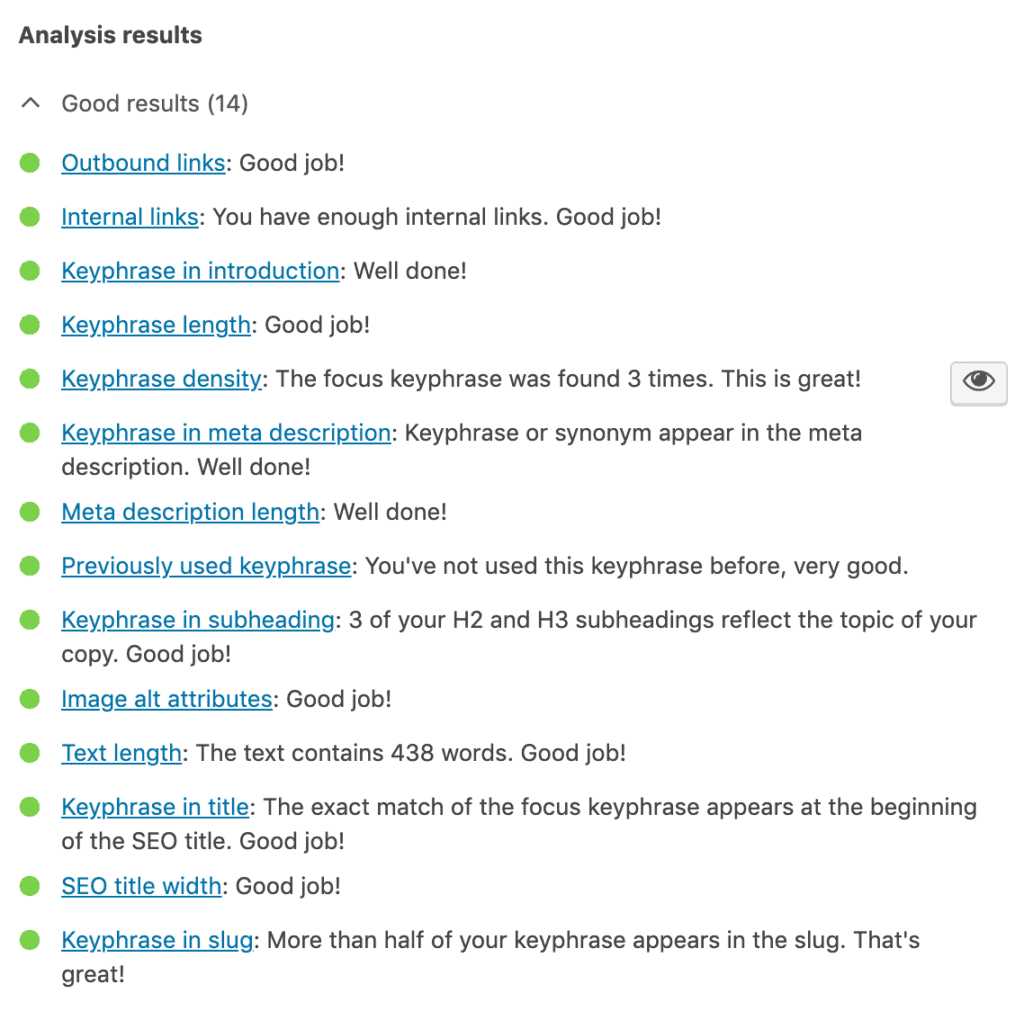After you publish a recipe, visitors will automatically start coming to your blog, right? Unfortunately, it’s not quite that simple! You have to make your blog post discoverable. When it comes to search results people need to be able to actually find your blog post. One of the ways this is accomplished is through keyword optimization.
Keyword optimization doesn’t just mean stuffing every sentence with your keyword like “chocolate chip cookies.” There’s a strategy behind placing those keywords. But don't sweat it, we’ll show you exactly where and how to use them in your content.
First things first. Before we get started, we recommend that you have an SEO plugin installed on your website. There are several free options out there, but one that many food bloggers like to use is Yoast SEO.
Yoast SEO is a great plugin as it acts as a checklist for optimizing your blog post. This makes the SEO process really straightforward and dare we say…easy?!
Below is an example of the Yoast SEO “checklist.”

Once you’ve decided on which keyword(s) you’d like to use for your blog post, you’ll want to make sure you place them in the correct places.
1. Headings
Headings and subheadings include h1, h2, and h3 tags. These are the titles that are shown at the top of a blog post (h1) and that can be found dividing up the post copy (h2, h3, etc.) Be sure to include your keyword in the h1 and in some of the subheadings as well.

2. Body Copy
The next place to add your keywords is in the body copy. This is where it can be easy to get carried away with adding in your keyword too often. Yoast SEO suggests a keyword density, or how often the keyword appears in the copy, between 0.5% and 3%. Pay attention to the plugin checklist as you add keywords to your post to make sure you aren’t overusing your keyword (AKA keyword stuffing.)
3. Title Tag
The title tag is the first thing visitors see when they view your post on a search engine results page (SERPs). Make it easy for search engines and users to know exactly what your post is about by adding your keyword to the title tag.

4. URL (or Slug)
The URL is another item people see in the SERPs. Your URL should include your keyword, and it should be in line with what people can expect your post to be about.
For example, instead of just using the default WordPress URL format: pinchofyum.com/p=78394, add your keyword to the slug so it appears like this instead: pinchofyum.com/creamy-tomato-lasagna-florentine.
Which one do you think people will be more likely to click on? Chances are high that it’s going to be the second example!

Adjusting your post’s slug to include your keyword will make your site appear more credible and it's another factor that Google will use to determine what your post is about.
5. Meta Description
The meta description is your chance to stand out from the competition in the SERPs. Consider it a short sales pitch for your recipe.
While it’s not directly tied to search engine rankings, your meta description can impact your blog's click-through-rate (CTR), or how many people are clicking on your post, which can impact your post’s ability to rank.
When writing your meta description, make sure you add in your keyword so that people (and Google) will know what your post is about before they even click.

6. Anchor Text
Anchor text is the clickable, colored text that links from one web page to another. It looks like this link to the WP Tasty homepage.
To optimize your links for SEO, you’ll want to place your keyword (or its synonym) in the anchor text. A natural place to include keyword-optimized anchor text is at the end of your post in a section like “More Recipes to Try.”

These are just a few of the places where you’ll want to make sure you include your keywords in your blog post.
Of course, we can’t wrap up this post without mentioning a couple more tips to round out your keyword knowledge.
7. LSI Keywords
According to Ahrefs, “LSI keywords are words and phrases that Google sees as semantically-related to a topic.” For example, related keywords for “jambalaya” could include “jambalaya with sausage,” “cajun seafood jambalaya,” or “best creole seasoning.”
LSIGraph has a great tool for helping you discover LSI Keywords for your recipe posts. In a nutshell, LSI Keywords help to provide more context to your content. Just one more thing that’s useful for Google to determine your rankings.
8. First 100 words
Did you know Google puts more weight on keywords that show up early in your post (the first 100 words?) This is why it is important to drop your keyword into the first paragraph of your post!
9. Intro Text
Going along with the previous point, writing a short introduction at the beginning of your post is a great way to “sell” your recipe and let readers, and Google, know what they can expect from your post before they start scrolling. Make sure your intro is attention-grabbing to keep users interested and improve your bounce rate.
10. Secondary Keywords
Secondary keywords are closely related to and help to support the primary keyword. If your primary keyword is “easy tomato soup”, your secondary keywords could include “simple tomato soup” or “quick tomato soup.” A user could use these keywords interchangeably in a search, and still see similar SERPs. So including both primary and secondary keywords in your post is crucial for gaining more organic traffic.
Now you have what it takes to start optimizing your blog posts' keywords! You’ll be moving up the ranks in no time. ?
